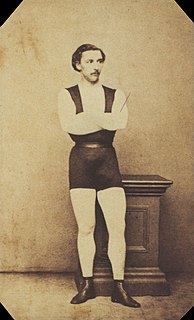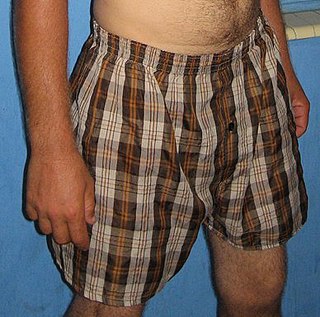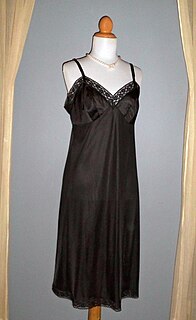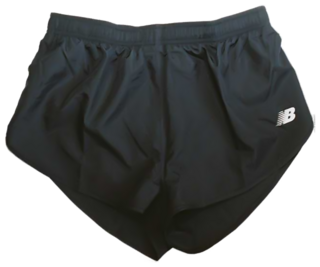
Lingerie is a category of primarily women's clothing including undergarments, sleepwear, and lightweight robes. The choice of the word is often motivated by an intention to imply that the garments are alluring, fashionable, or both. In a 2015 US survey, 75% of women and 26% of men reported having worn sexy lingerie in their lifetime.

A corset is a support garment commonly worn to hold and train the torso into a desired shape, traditionally a smaller waist or larger bottom, for aesthetic or medical purposes, or support the breasts. Both men and women are known to wear corsets, though this item was for many years an integral part of women's wardrobes.

A leotard is a unisex skin-tight one-piece garment that covers the torso from the crotch to the shoulder. The garment was made famous by the French acrobatic performer Jules Léotard (1838–1870). There are sleeveless, short-sleeved, and long-sleeved leotards. A variation is the unitard, which also covers the legs.

A skin-tight garment is a garment that is held to the skin usually by elastic tension using some type of stretch fabric. Commercial stretch fabrics ('elastomerics') such as spandex or elastane came onto the market in 1962, and revolutionized many areas of the clothing industry. A wide variety of clothing may be made to be skin-tight, and it is common for clothing to be skin-tight for some uses, such as in stockings, bodystockings, swimsuits and women's bras.

Tights are a kind of cloth garment, most often sheathing the body from the waist to the toe tips with a tight fit, hence the name. They come in absolute opaque, opaque, sheer and fishnet styles — or a combination, such as the original concept of the American term pantyhose with sheer legs and opaque panty.

Stockings are close-fitting, variously elastic garments covering the leg from the foot up to the knee or possibly part or all of the thigh. Stockings vary in color, design, and transparency. Today, stockings are primarily worn for fashion and aesthetics, usually in association with mid-length or short skirts.

Slip-ons are typically low, lace-less shoes. The style which is most commonly seen, known as a loafer or slippers in American culture, has a moccasin construction. One of the first designs was introduced in London by Wildsmith Shoes, called the Wildsmith Loafer. They began as casual shoes, but have increased in popularity to the point of being worn in America with business suits. Another design was introduced as Aurlandskoen in Norway. They are worn in many situations in a variety of colors and designs, often featuring tassels on the front, or metal decorations.

Panties are a form of women's underwear. Panties can be form-fitting or loose. Typical components include an elastic waistband, a crotch panel to cover the genitalia, and a pair of leg openings that, like the waistband, are often made of elastomer. Various materials are used, but are usually chosen to be breathable.

A nightgown, nightie or nightdress is a loosely hanging item of nightwear, and is commonly worn by women and girls. A nightgown is made from cotton, silk, satin, or nylon and may be decorated with lace appliqués or embroidery at the bust and hem.

A riding boot is a boot made to be used for horse riding. The classic boot comes high enough up the leg to prevent the leathers of the saddle from pinching the leg of the rider, has a sturdy toe to protect the rider's foot when on the ground and has a distinct heel to prevent the foot from sliding through the stirrup. The sole is smooth or lightly textured to avoid being caught on the tread of the stirrup in the event of a fall.

Boxer shorts are a type of undergarment typically worn by men. The term has been used in English since 1944 for all-around-elastic shorts, so named after the shorts worn by boxers, for whom unhindered leg movement ("footwork") is very important. Boxers come in a variety of styles and design but are characterized by their loose fit.

Leggings are several types of leg attire that have varied through the years. Modern usage from the 1960s onwards has come to refer to elastic close-fitting high-rise garments worn over the legs typically by women, such as leg warmers or tights. Usage from the 18th century refers to men's wear, usually made of cloth or leather that is wrapped around the leg down to the ankle. In the 19th century, leggings usually referred to infants' leg clothing that were matched with a jacket, as well as leg-wrappings made of leather or wool and worn by soldiers and trappers. Leggings prominently returned to women's fashion in the 1960s, drawing from the form-fitting clothing of dancers. With the widespread adoption of the synthetic fibre Lycra and the rise in popularity of aerobics, leggings came to further prominence in the 1970s and 1980s, and eventually made their way into streetwear. Leggings are a part of the late 2010s into the 2020s athleisure fashion trend of wearing activewear outside sporting activities and in casual settings.

Boardshorts are a type of swimwear and casual wear in the form of relatively long loose-fitting shorts that are designed to be quick-drying and are generally made from strong and smooth polyester or nylon material. Originally known as surf trunks, later as Jams, and occasionally in British English as swim shorts, boardshorts are a style of men's and, more recently, women's summerwear.

A slip is a woman's undergarment worn beneath a dress or skirt. A full slip hangs from the shoulders, usually by means of narrow straps, and extends from the breast to the fashionable skirt length. A half slip hangs from the waist. The word "petticoat" may also be used for half slips.

A kebaya is an upper garment traditionally worn by women in Southeast Asia, notably in Brunei, Indonesia, Malaysia, and Singapore. Outside of Southeast Asia, it is worn by Javanese, Malays and Portuguese Eurasians in Australian Cocos Islands and Christmas Island, coastal India and Sri Lanka, Macau as well as South Africa.

A dress shoe is a shoe to be worn at smart casual or more formal events. A dress shoe is typically contrasted to an athletic shoe.

Clothing fetishism or garment fetishism is a sexual fetish that revolves around a fixation upon a particular article or type of clothing, a particular fashion or uniform, or a person dressed in such a style.

Gym shorts are an article of clothing typically worn by people when exercising. They are typically made out of fabrics that allow for maximum comfort and ease, such as nylon. Brands such as Nike, Under Armour, Adidas, and Reebok all make gym shorts. Cotton gym shorts were made popular by a cheerleading brand called Soffe. Gym shorts or sweatpants are required for many junior high and high school physical education courses.

Undergarments or underwear are items of clothing worn beneath outer clothes, usually in direct contact with the skin, although they may comprise more than a single layer. They serve to keep outer garments from being soiled or damaged by bodily excretions, to lessen the friction of outerwear against the skin, to shape the body, and to provide concealment or support for parts of it. In cold weather, long underwear is sometimes worn to provide additional warmth. Special types of undergarments have religious significance. Some items of clothing are designed as undergarments, while others, such as T-shirts and certain types of shorts, are appropriate both as undergarments and as outer clothing. If made of suitable material or textile, some undergarments can serve as nightwear or swimsuits, and some are intended for sexual attraction or visual appeal.



















